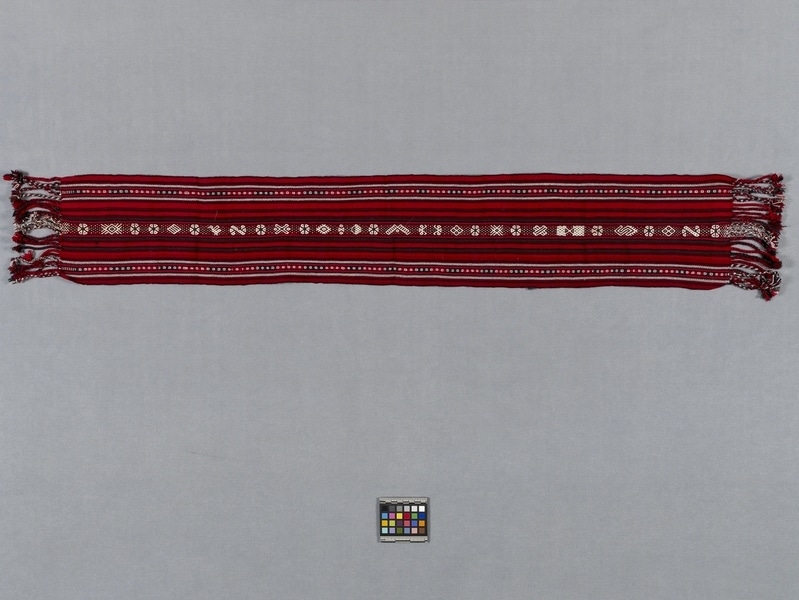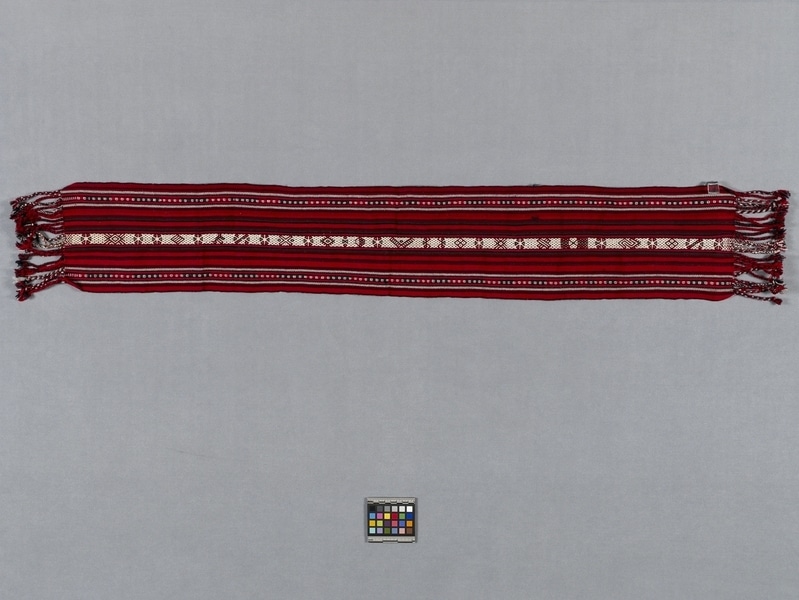Scarf Item Number: Sf920 from the MOA: University of British Columbia


Description
Scarf composed of green, blue and grey bands on a red background with a central band and narrower bands of repeating white squares near both side selvedges. The central band features variations on diamonds, crosses, reverse curves and circles as well as one bird. Fringed at both ends.
History Of Use
Warp-faced fabrics with three or four selvedges are woven by women but the fabrics the techniques, structures and some of the motifs have pre-Conquest antecedents. This type of textile conveys the most information about an individual's ethnicity, sex, age, status, and particular history. Scarves of different types are worn on various occasions. The 4 village authorities wear red scarves on their left shoulder. At weddings, men wear scarves around their necks. For Feb. 1 carnival, men wear them diagonally across the chest and back, fastened at the side of the waist. Not worn on an everyday basis.
Cultural Context
specific occasions;men
Iconographic Meaning
The range of motifs refers to local geography and landmarks, ecology, fecundity as well as luck. The six part circle refers to the division of land into six sections on Taquile and the rotation of crops and fallow periods. The cross and diamond filled with parallel lines refer to the furrows of the tilled fields.
Narrative
Bought from Silvia Yucra Huatta who made it. It has not been used but it would have been used by her husband, if she had not sold it.
Specific Techniques
Weave structures are the following: 1-plain colour areas are warp faced plain weave. 2- figurative designs; complementary-warp weave with 3-span floats aligned in alternate pairs with an irregular (abbabaab) warping order (3/1 horizontal colour changes and diagonals of 2-span floats). 3- stripe with squares; float weave derived from turned 2/1 horizontal herringbone with floats forming squares.
Item History
- Made by Silvia Yucra Huatta (Maker) in Taquile, Puno, Peru during 1982
- Collected by Mary Frame during 1982
- Owned by Mary Frame before February 10, 1983
- Received from Mary Frame (Seller) and Museum of Anthropology Shop Volunteers (Funding source) on February 10, 1983
What
- Name
- Scarf
- Identification Number
- Sf920
- Type of Item
- scarf
- Material
- wool fibre and synthetic fibre
- Manufacturing Technique
- woven, retwisted, plied and spun
- Overall
- height 18.9 cm, width 128.0 cm
Who
- Culture
- Quechua
- Creator
- Silvia Yucra Huatta (Maker)
- Field Collector
- Mary Frame
- Previous Owner
- Mary Frame
- Received from
- Mary Frame (Seller) and Museum of Anthropology Shop Volunteers (Funding source)
Where
- Holding Institution
- MOA: University of British Columbia
- Made in
- Taquile, Puno, Peru
When
- Creation Date
- during 1982
- Collection Date
- during 1982
- Ownership Date
- before February 10, 1983
- Acquisition Date
- on February 10, 1983
Other
- Item Classes
- textiles
- Condition
- good
- Accession Number
- 0861/0015